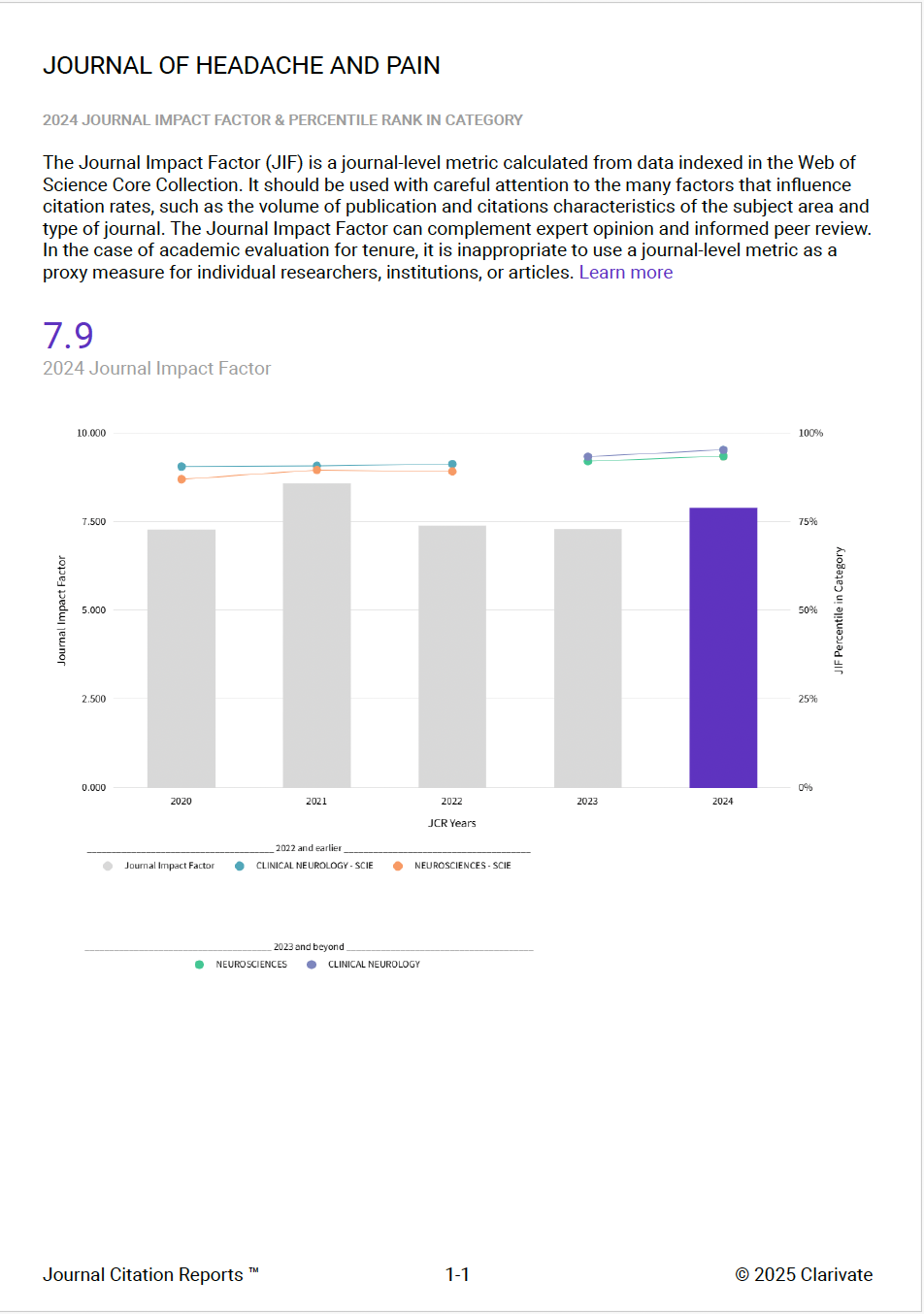The Journal of Headache and Pain: From Utopian Heresy to Scientific Leadership in the Field
Published in Neuroscience, Biomedical Research, and General & Internal Medicine

The years when the founding of The Journal of Headache and Pain was considered a heretical endeavor are now long gone. What began as a utopian vision has evolved into established leadership in the field, reinforced by a consecutive four-year track record of excellence and anchored in solid resilience.
Before delving into the analytical review of the 2024 metrics, I would like to highlight just two institutional milestones that have quietly left their mark on this journey: The first was a 2007 Consensus that secured the Official WHO Logo, and the second was the 2018 Position Paper developed in Official Collaboration with the European Medicines Agency.
Other highly successful strategic initiatives have included the Collections, the inclusive recruitment of young talents beyond traditional scientific networks, which gave rise to the Juniors’ Vision Projects Part 1 and Part 2, and the 2025 Early Career Research Mentorship Program. The latter, through outstanding papers, exhausted its annual quota of 10 waivers for winners within just a few weeks. Applications for the 2026 Edition open early next year.
Unfortunately, it must also be noted that the anticipated coverage of global unmet needs with innovative drugs has fallen far short of expectations, failing to reduce the disease burden as demonstrated in various Global Burden of Diseases Studies.
One last key point before discussing the metrics is surpassing the threshold of 50% new authors compared to historical ones.
And now, the detailed analysis of the 2024 metrics: 
2-Year Impact Factor (Clarivate)
The 2024 2-year impact factor is 7.9, an increase from a score of 7.3 in 2023.
The new impact factor is based on 9027 citations made in 2024 to 309 citable items published in 2022 and 2023. For comparison, the 2023 IF was based on 8,166 citations made in 2023 to 292 citable items published in 2021 and 2022.
The Impact Factor without self-citations is 6.6.
TJHP now stands at 14/285 in the category Clinical Neurology (19/277 in 2023), and in Neurosciences it is now ranked 21/314 (previously 26/310). This is the highest ranking in both categories that the journal has held. In both categories, TJHP is also the highest ranked journal with a specific focus on headache.
5-year Impact Factor (Clarivate)
The 2024 5-year impact factor is 7.4, down slightly from 7.7 in 2023. The 5-year impact factor is an indicator of the sustained impact of journal publications. For 2024, the score is calculated from citations made in 2024 of articles published by the journal between 2019 and 2023.
Immediacy Index (Clarivate)
The 2024 Immediacy Index is 1.7, down slightly from 1.9 in 2023. The Immediacy Index indicates the number of citations to articles published within the same year, and so demonstrates how quickly recently published research is cited. This year, the score is calculated from citations made in 2024 of articles published by TJHP in 2024.
Journal Citation Indicator (JCI) (Clarivate)
Additionally, the Journal Citation Indicator (JCI) for TJHP has increased to 1.99 for 2024, from 1.92 in 2023. The JCI calculates the average Category Normalized Citation Impact of citable items published by the journal over a recent three-year period, with the category average score 1.0.
EigenFactor (Clarivate)
TJHP has a 2024 EigenFactor score of 0.01105 (an increase from 0.01072 in 2023). The EigenFactor calculates the number of journal article citations over 5 years, factoring in the impact factor of the citing journal and excluding self-citations.
CiteScore (Scopus)
The CiteScore for TJHP has decreased, from 11.8 in 2023, to 11.1 in 2024. The journal dropped in both categories for the 2024 CiteScore, from 4/136 in 2023 to 5/139 in 2024 in the category Anesthesiology and Pain Medicine, and from 27/400 in 2023 to 30/400 in 2024 in the category Neurology (clinical).
SCImago Scientific Journal Ranking (SJR) (Scopus)
The SCImago SJR for TJHP increased to 2.066 in 2024, from 1.791 in 2023. This places the journal in the top quartile for the categories Anesthesiology and Pain Medicine, Neurology (clinical), and Medicine (miscellaneous). The SCImago SJR calculates the number of journal article citations within a year (2024), of articles posted over 3 years (2021-2023), factoring in the prestige of the citing journal.
Usage
Article downloads for TJHP decreased in 2024, from just above 3 million in 2023 to 2.7 million in 2024.
We acknowledge the credit for this success to all those who have served and continue to serve on the various Boards over time. We acknowledge the dedication of all the referees who have worked to enhance the quality of the scientific contributions from the many authors. We acknowledge the merit of the numerous Authors who have chosen this challenging stage to make their scientific voices heard. We acknowledge the support of Scientific Societies connected to TJHP by a well-established partnership. We acknowledge the top-tier professionalism of our Publisher, Springer Nature. We even acknowledge the murmured scorn for the ones who see—and fail to act— (Dante’s Inferno, Canto III) to whom we have always spared but a fleeting glance.
Let us continue our stroll down this Via Condotti of headaches, admiring the exquisite, finely crafted works that will continue to grace its glittering storefronts.
Paolo Martelletti, on behalf of all Editors 2000-2025
Follow the Topic
-
The Journal of Headache and Pain

The Journal of Headache and Pain is a peer-reviewed open access journal specifically dedicated to researchers involved in all aspects of headache and related pain syndromes, including epidemiology, public health, basic science, translational medicine, clinical trials and real-world data.
Your space to connect: The Psychedelics Hub
A new Communities’ space to connect, collaborate, and explore research on Psychotherapy, Clinical Psychology, and Neuroscience!
Continue reading announcementRelated Collections
With Collections, you can get published faster and increase your visibility.
Focus Africa
The Journal of Headache and Pain is calling for submissions to our Collection on Focus Africa. Migraine is a major cause of disability worldwide, yet research efforts and healthcare strategies remain unevenly distributed across regions. In Africa, diverse populations and healthcare landscapes present unique challenges in the recognition, diagnosis, and management of migraine and other headache disorders. This thematic collection, Focus Africa, aims to enhance understanding of these conditions by exploring epidemiological trends, healthcare disparities, cultural influences, financial constraints, gender-related factors, and the availability of treatment options across the continent.
We invite submissions of original research, systematic and narrative reviews, editorials, rapid reviews, and commentaries on topics including, but not limited to:
• The prevalence, burden, and impact of migraine and other headache disorders across African countries
• Socio-economic and cultural determinants of headache disorders in Africa
• Insights into the pathophysiology of migraine from an African perspective
• Barriers to headache care, healthcare inequalities, and policy solutions
This Collection provides a dedicated platform for African researchers and clinicians to contribute to global headache science while addressing the specific needs of the region. By fostering collaboration and knowledge exchange, Focus Africa aims to drive meaningful advancements in migraine and headache disorders research and care across the continent.
Therefore, the collection welcomes researchers from author groups all with their main affiliated institution in Africa. Cross-continental authorship groups are welcome to submit their work to The Journal of Headache and Pain outside of this collection.
Springer Nature offers article processing charges (APC) waivers and discounts for articles published in our fully open access journals whose corresponding authors are based in the world’s lowest income countries (see our APC waivers and discounts policy for further information). Requests for APC waivers and discounts from other authors will be considered on a case-by-case basis and may be granted in cases of financial need (see our open access policies for journals for more information). All applications for discretionary APC waivers and discounts should be made at the point of manuscript submission; requests made during the review process or after acceptance are unable to be considered. Should applications for financial support via the above process be unsuccessful, authors are encouraged to reach out to the journal.
Publishing Model: Open Access
Deadline: Dec 20, 2025
The Epigenome and Transcriptome in Headache Disorders
The thematic series titled "The Epigenome and Transcriptome in Headache Disorders" focuses on the latest advancements in the studies on the epigenome and transcriptome in headache research, aiming to elucidate the complex neurological mechanisms underlying headache disorders, particularly migraine and tension-type headaches. This collection explores how the regulation of gene expression with a special emphasis on its epigenetic and transcriptomics components with corresponding techniques are being applied to analyze clinical, neurophysiological, and molecular data, uncovering patterns and subtle relationships within the intricate landscape of headache-related phenomena.
The studies of the epigenome and transcriptome offer new perspectives for understanding the complex interplay between genetic predispositions, environmental triggers, and individualized symptomatology. This collection delves into how epigenetic modifications influence the onset, frequency, and individual variability of headaches, providing insights that support the development of personalized treatment strategies and advancing the field of precision medicine.
Additionally, the collection highlights the potential of the epigenome and transcriptome in enhancing early diagnosis, predicting headache occurrences, and optimizing treatment approaches. Through innovative molecular biology techniques, the collection aims to offer a deeper understanding of headache disorders and pave the way for more effective therapeutic interventions.
The collection also invites discussion on the ethical implications of diagnostic and therapeutic approaches based on epigenetic and transcriptome findings. Our goal is to improve the quality of headache diagnosis and treatment in an effective and ethically responsible manner.
This Collection supports and amplifies research related to SDG 3, Good Health and Well-Being.
All submissions in this collection undergo the journal’s standard peer review process. Similarly, all manuscripts authored by a Guest Editor(s) will be handled by the Editor-in-Chief. As an open access publication, this journal levies an article processing fee (details here). We recognize that many key stakeholders may not have access to such resources and are committed to supporting participation in this issue wherever resources are a barrier. For more information about what support may be available, please visit OA funding and support, or email OAfundingpolicy@springernature.com or the Editor-in-Chief.
Publishing Model: Open Access
Deadline: Feb 28, 2026

Please sign in or register for FREE
If you are a registered user on Research Communities by Springer Nature, please sign in
Wishing TJHP continued success under the leadership of Professor Paolo. With united efforts, may we overcome the challenge of headaches together.@Paolo
Excellent, Professor! Indeed, a very courageous initiative, which is applauded Today. I wish Brazil could be more like this, and with less envy and sabotage.